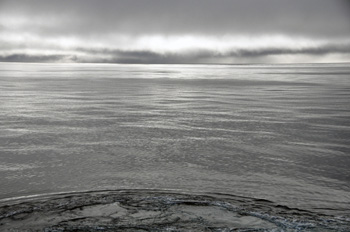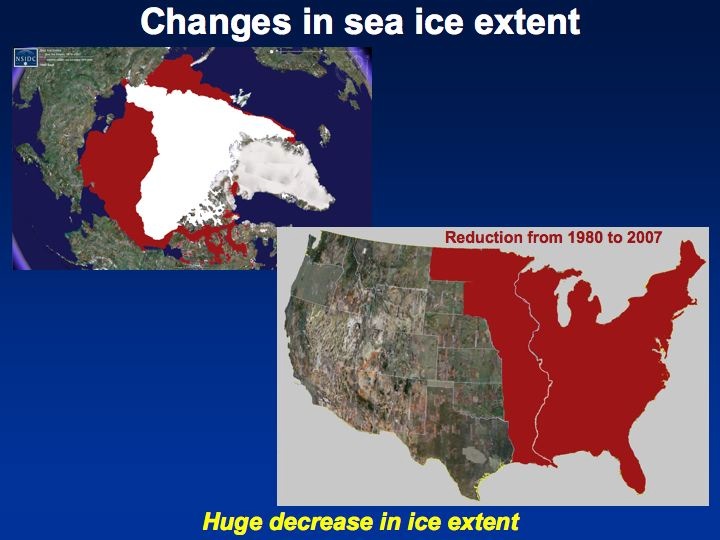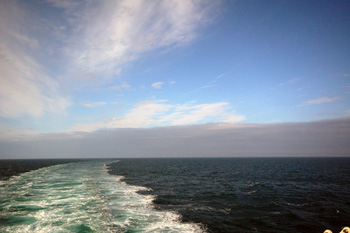September 13th
Mark Serreze, National Snow & Ice Data Center “The Climate is an angry beast and we’re poking it with sticks.”Wallace Broecker, Lamont-Doherty Earth Observatory The alarms have been sounding for years now; we should be well aware of the climate peril. If not, our ignorance is willful, since information, outcries, and warnings are everywhere around us. Let’s ignore the vested interests, the corporate claques, and the cabal of radicals who deny unbendingly that climate change due to anthropogenically induced global warming is real or contend that it is some kind of conspiracy—facts, research, science don’t move them—and go at the matter from an Arctic-science perspective. That, after all, is the reason we’re out here with so many different kinds of scientists, to document the present state of the Arctic at a moment before everything changes. Ice is a logical place to begin, since ice is synonymous with “Arctic.” Last June, Don Perovich from the Cold Regions Research & Engineering Lab, who was serving as co-chief scientist aboard Healy in these very waters, gave a succinct and troubling presentation to crew and scientists. In 1980, the Arctic ice cap—the region that remains perpetually frozen—covered 7.8 million square kilometers. In 2007, it covered 4.2 million sq. km. This, he demonstrated, was a loss of ice comparable in area to the United States east of the Mississippi River plus the row of states on the west side of the river. It took me a moment to grasp the magnitude of those numbers. But not only is this a staggering quantity of ice loss per se, it indicates a consistent, rapid, and on-going loss. September—right now—is the usual ice minimum for the Arctic. We haven’t seen any ice so far, nor did Dr. Bob expect to. However, Knut Aagaard, a universally respected old Arctic hand, told Bob that two decades ago the kind of work he’s doing now would likely have been out of the question. The sea would have been frozen solid. During August, the daily rate of decline was 55,000 sq. km. of ice. The second lowest ice extent since the advent of satellite recording occurred in 2010. The lowest occurred in 2007. The National Snow & Ice Data Center, source of these figures, states baldly: “Sea ice is in decline in all months and the rate of decline is greater and faster than natural causes can account for.” Some highly regarded climatologists and geophysicists are saying that the Arctic will be ice-free in summer within ten years. The melting is tearing the heart out of the Arctic.
So what? I live in New York City, where the Arctic doesn’t even come up in conversation, unless I bring it up. And what of you students from Indiana, Washington, Massachusetts, the UK? What matters an ice-free Arctic to you. Let’s ignore until later the loss of a magnificent environment rich in wonderful ice-adapted animals, to say nothing of the indigenous people, that will inevitably result, and answer the question in terms of human interests and well-being down in the temperate zones: The Arctic ice cap is, or has been, so large for so long that its climatic influence sprawls far beyond its edges. It is, therefore, a “geophysical force.” The Antarctic Ice Sheet is another, so are volcanoes and the Trade Winds. Geophysical forces cannot change significantly (or disappear) without serious changes reverberating, literally, around the world. The other day we talked about the feedback process by which highly reflective sea ice, when it melts, exposes unreflective ocean water, which then absorbs more sunlight causing more warming, thus melting more ice and so on until the ice is gone. In scientific lingo the measure of a surface’s reflectivity is called its albedo. Ice, which reflects 80% of sunlight, has a high albedo. Oceans absorb 90% of incoming sunlight, and so have a low albedo. It’s easy, then, to see how the presence of ice will lower temperatures, and its absence will raise them. The melting is tearing the heart out of the Arctic. The point we need always to keep in mind is that nature’s great systems are dynamic, circular and interconnected (nature loves circles because circles conserve mass, or to put unscientifically, what goes around comes around.). Increased warming in the Arctic due to increased albedo will not just sit there out of sight and mind in the Arctic while we get on with our lives. No, the warming and increased freshwater from Greenland Ice Cap, which is also melting, will be transported southward by the natural circulation of air and ocean currents, while at the same time altering those currents’ course and their climatic affect on the rest of the globe. The temperate zones, where most of us live, are also warming, and no serious scientist doubts it. But it’s not so noticeable because our environment is not characterized by a substance so vulnerable to warming as ice.
The concrete impacts are not entirely predictable, but some stand to simple scientific reasoning. For example, when ice is present, less moisture moves from the ocean surface into the atmosphere than when it is absent. Moisture is fuel for storms. Will there be more storms? Will they be more powerful than normal? In any case, we can’t expect that an anomalous influx this large won’t have significant impact on the systems we rely upon for our regular weather and long-term climate, i.e. the Gulf Stream and the jet stream—because of that very interconnectedness. Maybe we should keep one other matter in mind: We—humans—have, by our numbers and our works, become a geophysical force in our own right. We didn’t mean for our very way of living to have destructive impact. We recognized years ago our capacity to uproot environments, only more recently our capacity to alter world climate. Now we know, but the question stills hangs as to whether we’ll find the will and means to adopt sustainable lifestyles. Sadly, my generation seems, at least right now, to deny the means and to evince little will, so I suspect both the impacts and the responsibility will fall to the younger generation. * * * The weather’s changed, a cold 25-knot wind is blowing southeast, and the fog is gone. We’re heading north sampling temperature, salinity, and current velocity in water about two miles deep. But still no ice. After they complete that section, we’ll turn east. Dr. Bob wants to know what happens to the Western Arctic Boundary Current in water farther east than he’s been before. Then we’ll turn north again and look for the edge of the ice pack. Bob wants to leave a meteorological station on the ice. And the rest of us hope for the opportunity get off and walk on the frozen ocean.
Last updated: September 28, 2010 | |||||||||||||||||||
Copyright ©2007 Woods Hole Oceanographic Institution, All Rights Reserved, Privacy Policy. | |||||||||||||||||||



